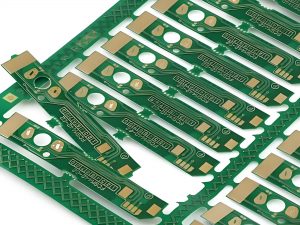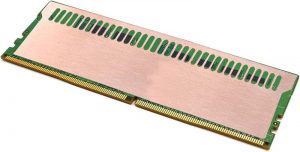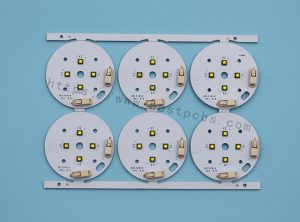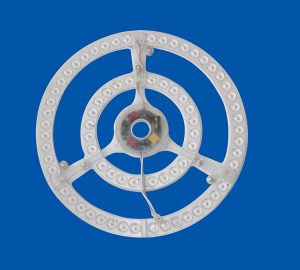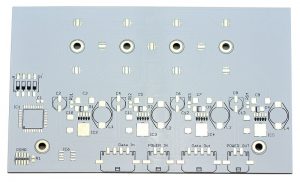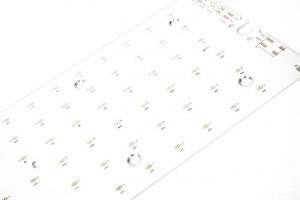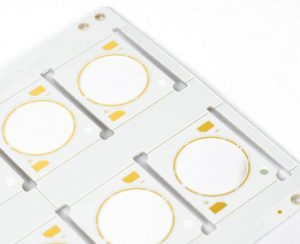In today’s era of rapid technological development, the performance and reliability of electronic equipment are attracting more and more attention. Among many electronic components, aluminum pcb have become an indispensable part of the electronics field with their excellent performance and wide application.
How do you make Aluminum PCB?
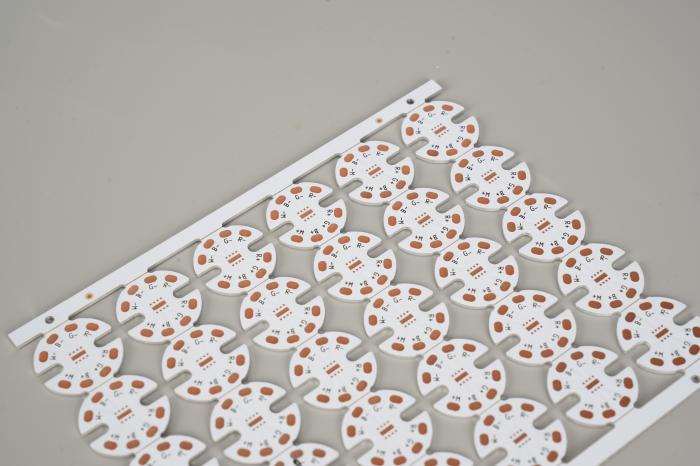
- 1. Cutting: Cut large-sized incoming materials into the size required for production. The process is picking materials-cutting.
- 2. Drilling: Positioning and drilling holes in the plate to assist the subsequent production process and customer assembly. The drilling process is pinning-drilling-board inspection.
- 3. Dry/wet film imaging: The part required for making the circuit is presented on the plate. The dry/wet film imaging process is grinding the plate-filming-exposure-development.
- 4. Acid/alkaline etching: After dry/wet film imaging, the required circuit part is retained and the excess part outside the circuit is removed. The acid/alkaline etching process is etching-film stripping-drying-board inspection.
- 5. Silkscreen solder mask and characters: solder mask is to protect the circuit that does not need soldering, preventing tin from entering and causing short circuit. Characters are used for marking. The silkscreen solder mask and character process is silkscreen – pre-baking – exposure – development – characters.
- 6. V-CUT, gong board: V-CUT is to cut the single PCS circuit and the whole PNL board to leave a small part connected for easy packaging and removal. The gong board is to remove the excess part of the circuit board. The process of V-CUT and gong board is V-CUT – gong board – tearing the protective film – removing the flash.
- 7. Test, OSP: Circuit test is to detect whether the completed circuit is working normally. Voltage resistance test is to detect whether the completed circuit can withstand the specified voltage environment. OSP allows the circuit to be better soldered. The test, OSP process is circuit test – voltage resistance test – OSP.
- 8. FQC, FQA, packaging, shipment: FQC conducts full inspection and confirmation of the product, FQA conducts random inspection and verification, and packages and ships to customers as required. The process is FQC-FQA-packaging-shipping.
What are the layers of aluminum PCB?
Aluminum-based circuit boards (PCBs) mainly consist of three layers, namely the circuit layer (copper foil), the insulation layer, and the metal base layer. This structure gives aluminum-based PCBs excellent heat dissipation performance and mechanical strength, making them particularly suitable for applications that require efficient heat dissipation and good mechanical properties.
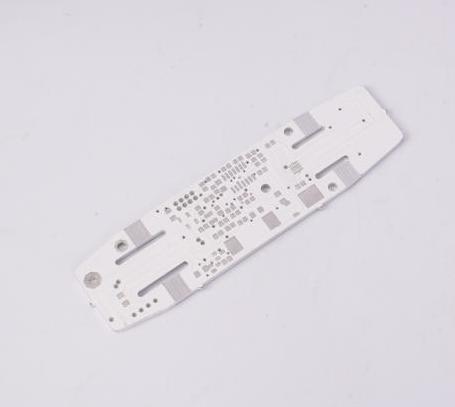
The circuit layer is usually made of copper foil, which is etched to form a printed circuit for assembly and connection of devices. The thickness of the copper foil can be between 1oz and 10oz to ensure the conductivity and load-bearing capacity of the circuit.
The insulation layer is the core technology of aluminum-based PCBs. It uses low thermal resistance thermal insulation materials with a thickness of 0.003″ to 0.006″ inches and has good bonding, insulation and thermal conductivity.
The metal base layer is generally aluminum or copper, which has good thermal conductivity and certain mechanical strength. It can quickly conduct the heat generated during device operation, effectively reduce the operating temperature of the device, and improve the power load and reliability of the module.
In addition, according to the specific application requirements, aluminum clad PCB can be designed as single-sided board, double-sided board or very few multi-layer boards. Single-sided board consists of three-layer structure, while double-sided board adds a circuit layer on this basis, forming a structure of circuit layer, insulation layer, aluminum base, insulation layer, circuit layer.
How thick is aluminum clad PCB?
The thickness of aluminum clad board usually ranges from 0.2mm to 10mm, and the specific choice depends on the number of layers and purpose of the circuit board.
0.2mm to 0.5mm aluminum clad board is suitable for making single-sided circuit boards, 0.5mm to 1.2mm is suitable for double-sided circuit boards, and 1.2mm to 2.0mm is suitable for multi-layer circuit boards.
In addition, common standard thicknesses also include 0.5mm, 1.0mm, 1.5mm, etc. For the PCB board itself, common thicknesses are 0.6mm, 1.0mm, 1.6mm, 2.0mm, 2.4mm, etc.
The standard PCB thickness ranges from 0.031 inches (0.78 mm), 0.062 inches (1.57 mm), and 0.093 inches (2.36 mm), with the most commonly used thickness being 0.063 inches (1.57 mm or 157 mm).
The thickness of conventional PCB finished products is generally between 0.8 mm and 1.6 mm, with 1.6 mm being the most common specification‚ÄĆ.
What are aluminum PCBs used for?
Aluminum substrate PCB (aluminum PCB) is a metal-based copper-clad board with good heat dissipation function. It consists of a circuit layer (copper foil), an insulating layer and a metal base layer. Sometimes it is also designed as a double-sided board or a multi-layer board structure.
The application of aluminum substrates is very wide, covering multiple fields and equipment, mainly including:
- 1. Audio equipment: used for input and output amplifiers, balanced amplifiers, audio amplifiers, preamplifiers, power amplifiers, etc.
- 2. Power supply equipment: including switching regulators, DC/AC converters, SW regulators, etc.
- 3. Communication electronic equipment: suitable for high-frequency amplifiers, filtering appliances, signal transmission circuits, etc.
- 4. Office automation equipment: such as motor drives, etc.
- 5. Automotive electronics: used in electronic regulators, igniters, power controllers, etc.
- 6. Computers: including CPU boards, floppy disk drives, power supply equipment, etc.
- 7. Power modules: such as inverters, solid-state relays, rectifier bridges, etc.
- 8. Lamps and lighting: As an advocate of energy-saving lamps, aluminum substrates are increasingly used in various color energy-saving LED lamps.
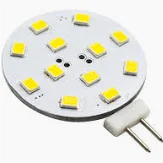
Aluminum substrate PCBs are particularly favored in high-end electronic devices due to their excellent heat dissipation performance and reliability, and are widely used in various occasions that require efficient heat dissipation.
What are the disadvantages of aluminum PCB?
The main disadvantages of aluminum PCBs include high cost, usually only single-sided panels can be made, electrical strength and withstand voltage are more prone to problems, thermal conductivity test methods and test results are not matched, aluminum substrate material specifications are not unified, copper foil thickness does not meet the standard, and there are more defective products and shoddy work. ‚ÄĆ
- 1. High cost: The price of aluminum substrates usually accounts for more than 30% of the product price, which is significantly higher than other types of PCBs.
- 2. Production limitations: Aluminum substrates can usually only produce single-sided boards, and the process of producing double-sided boards is more difficult, which limits their use in some applications.
- 3. Electrical strength and withstand voltage issues: Aluminum substrates are more prone to problems in electrical strength and withstand voltage, which may affect the safety and reliability of the product.
- 4. Thermal conductivity test and material specification issues: The mismatch between the test methods and test results of thermal conductivity, as well as the lack of unified material specifications for aluminum substrates (there are CPCA industry standards, national standards, and international standards, etc.), all increase the complexity of production and quality control.
- 5. Copper foil thickness and defective products: Failure to meet the copper foil thickness standards may lead to problems such as burning circuits. At the same time, due to cutting corners and increasing defective products, the quality control of aluminum substrates has become more difficult.
These shortcomings limit the application scope of aluminum substrates to a certain extent and increase the risks of production and use. Therefore, when choosing to use aluminum substrates, it is necessary to comprehensively consider their advantages and disadvantages, as well as specific application requirements and environmental conditions.
What temp can aluminum PCB withstand?‚ÄĆ
The high temperature resistance of aluminum substrates is related to the materials used, manufacturing process and working environment. Under normal circumstances, aluminum substrates can withstand a wide range of temperatures, but the specific temperature resistance is also affected by factors such as solder paste and lamp quality.
The temperature that aluminum substrates can withstand during welding can reach about 400 degrees Celsius, and the welding time is about 30 seconds to 50 seconds, of which the actual melting time is only 10 seconds, which shows that aluminum substrates can withstand higher temperatures in a short period of time without damaging the components.‚ÄĆ
In addition, aluminum substrates, like other types of PCB boards (such as FR4 boards, copper substrates, etc.), can withstand an ambient temperature range of -40‚ĄÉ to +150‚ĄÉ.
However, in long-term use, the highest temperature that these boards can withstand is between 120‚ĄÉ and 130‚ĄÉ‚ÄĆ. This shows that although aluminum substrates and other types of PCB boards can work in a wide temperature range, their performance and life will be affected to a certain extent when working in a high temperature environment for a long time.
In short, as an important component in the field of electronics, aluminum substrates have excellent performance and broad application prospects. I believe that in the future, with the continuous advancement of technology, aluminum substrates will play a more important role in the field of electronics.
Tags: aluminum pcb, MCPCB, PCB


